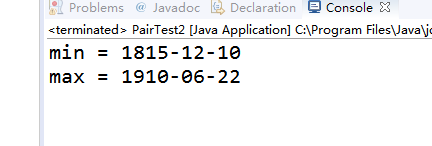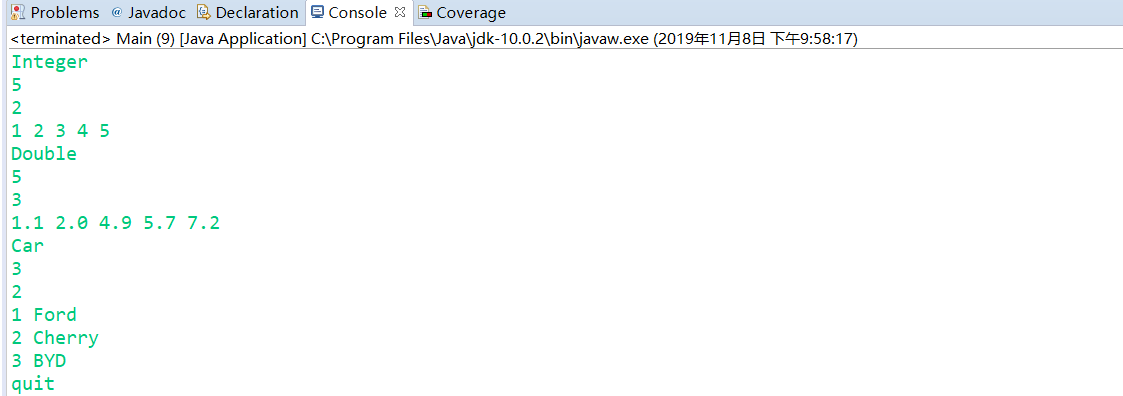201871010132--张潇潇--《面向对象程序设计(Java)》第十一周学习总结
博文正文开头格式:(2分)
|
项目 |
内容 |
|
这个作业属于哪个课程 |
https://www.cnblogs.com/nwnu-daizh/ |
|
这个作业的要求在哪里 |
https://www.cnblogs.com/nwnu-daizh/p/11435127.html |
|
作业学习目标 |
|
第一部分:总结第八章关于泛型程序设计理论知识(25分)
8.1 为什么要使用泛型程序设计
从Java1.0版发布以来,变化最大的就是泛型。使用泛型机制编写的程序代码要比那些杂乱的使用object变量,然后再进行强制类型转换的代码具有更好的安全性和可读性
泛型程序设计意味着编写的代码可以被很多不同类型的对象所重用。
在Java中增加泛型类之前,泛型程序设计是用继承实现的。但是有两个问题:
当获取一个值时必须进行强制类型转换
这里没有错误检查,可以向数组列表中添加任何类的对象
类型参数的魅力在于:使得程序具有更好的可读性和安全性
JDK开发人员已经做出了很大的努力,为所有的集合类提供类类型参数!!!
8.2 定义简单泛型类
类型变量使用大写形式,且比较短,这是很常见的。在Java库中,使用变量E来表示集合的元素类型,K和V来表示关键字与值的类型。T表示“任意类型”
8.3 泛型方法
实际上,还可以定义一个带有类型参数的简单方法:
class ArrayAlg{
public static<T> T getMiddle(T...a) {
return a[a.lengtyh / 2];
}
}
类型变量放在修饰符的后面,返回类型的前面。当调用一个泛型方法时,在方法名钱的尖括号中放入具体的类型:
String middle = ArrayAlg.<String>getMiddle("John", "Holk");
1
8.4 类型变量的限定
有时,类或方法需要对类型变量加以约束
class ArrayAlg{
public static<T> T min(T[] a) {
if(a == null || a.length == 0) return null;
T smallest = a[0];
for(int i = 1; i < a.length;i++)
if(smallest.compareTo(a[i]) > 0) smallest = a[i]
return smallest;
}
}
这里有·问题,解决问题的方法是实现Comparator接口
public static <T extends Comparator> T min(T[] a)...
1
一个类型变量或通配符可以有多个限定,例如:
T extends Comparator & Serializable
限定类型用&分割,逗号用来分割类型变量
在Java的继承中,可以根据需要拥有多个接口超类型,但限定类只能有一个。如果用一个类做限定,必须把这个类写在限定列表的第一个
8.5 泛型代码和虚拟机
原始类型用一个限定类型变量来替换,如果没有限定就替换成Object(类型擦除)
关于Java泛型转换的事实:
虚拟机中没有泛型,只有普通的类或方法
所有类型参数都用它们的限定类型替换
桥方法被合成来保持多态
为保持类型安全性,必要时加入强制类型转换
8.6 约束和局限性
不能用基本类型实例化类型参数
运行时类型查询只适用于原始类型
不能创建参数化类型的数组
Varargs警告
不能实例化类型变量
不能构造泛型数组
泛型类的静态上下文中类型变量无效
不能抛出或捕获泛型类的实例
可以消除对受查异常的检查
注意擦除后的冲突
8.7通配符:“?”符号表明参数的类型可以是任何一种类型,而T表示一种未知类型。
通配符的一般用法:a.?:用于表示任何类型;
b.? extends type,表示带有上界;
c.? super type,表示带有下界。
二:实验部分。
1、实验目的与要求
(1) 理解泛型概念;
(2) 掌握泛型类的定义与使用;
(3) 掌握泛型方法的声明与使用;
(4) 掌握泛型接口的定义与实现;
(5)了解泛型程序设计,理解其用途。
2、实验内容和步骤
实验1: 导入第8章示例程序,测试程序并进行代码注释。
测试程序1:
l 编辑、调试、运行教材311、312页 代码,结合程序运行结果理解程序;
l 在泛型类定义及使用代码处添加注释;
l 掌握泛型类的定义及使用。
程序如下:
/**
* @version 1.01 2012-01-26
* @author Cay Horstmann
*/
public class PairTest1
{
public static void main(String[] args)
{
String[] words = { "Mary", "had", "a", "little", "lamb" };//初始化一个String对象数组
Pair<String> mm = ArrayAlg.minmax(words);//一对字符串:min,max
System.out.println("min = " + mm.getFirst());
System.out.println("max = " + mm.getSecond());
}
} class ArrayAlg
{
/**
* Gets the minimum and maximum of an array of strings.
* @param a an array of strings
* @return a pair with the min and max value, or null if a is null or empty
*/
public static Pair<String> minmax(String[] a)//普通方法,定义minmax为字符串类型
{
if (a == null || a.length == 0) return null;
String min = a[0];
String max = a[0];
//将元素的泛型具体声明 for (int i = 1; i < a.length; i++)//length:数组属性值
{
if (min.compareTo(a[i]) > 0) min = a[i];
if (max.compareTo(a[i]) < 0) max = a[i];
}//实现字符串比较大小
return new Pair<>(min, max);
}
}
/**
* @version 1.00 2004-05-10
* @author Cay Horstmann
*/
public class Pair<T>//类型变量(放在类名后面)
{
private T first;
private T second; public Pair() { first = null; second = null; }
public Pair(T first, T second) { this.first = first; this.second = second; } public T getFirst() { return first; }
public T getSecond() { return second; } public void setFirst(T newValue) { first = newValue; }
public void setSecond(T newValue) { second = newValue; }
}
运行结果如下:

测试程序2:
l 编辑、调试运行教材315页 PairTest2,结合程序运行结果理解程序;
l 在泛型程序设计代码处添加相关注释;
l 掌握泛型方法、泛型变量限定的定义及用途。
程序如下:
import java.time.*; /**
* @version 1.02 2015-06-21
* @author Cay Horstmann
*/
public class PairTest2
{
public static void main(String[] args)
{
LocalDate[] birthdays =
{
LocalDate.of(1906, 12, 9), // G. Hopper
LocalDate.of(1815, 12, 10), // A. Lovelace
LocalDate.of(1903, 12, 3), // J. von Neumann
LocalDate.of(1910, 6, 22), // K. Zuse
};
Pair<LocalDate> mm = ArrayAlg.minmax(birthdays);
System.out.println("min = " + mm.getFirst());
System.out.println("max = " + mm.getSecond());
}
} class ArrayAlg
{
/**
Gets the minimum and maximum of an array of objects of type T.
@param a an array of objects of type T
@return a pair with the min and max value, or null if a is
null or empty
*/
public static <T extends Comparable> Pair<T> minmax(T[] a) //泛型方法(comparable是T的上界约束)
{
if (a == null || a.length == 0) return null;
T min = a[0];
T max = a[0];//min和max与T的类型一致
for (int i = 1; i < a.length; i++)
{
if (min.compareTo(a[i]) > 0) min = a[i];
if (max.compareTo(a[i]) < 0) max = a[i];
}
return new Pair<>(min, max);
}
}
/**
* @version 1.00 2004-05-10
* @author Cay Horstmann
*/
public class Pair<T> //类型变量
{
private T first;
private T second; public Pair() { first = null; second = null; }
public Pair(T first, T second) { this.first = first; this.second = second; } public T getFirst() { return first; }
public T getSecond() { return second; } public void setFirst(T newValue) { first = newValue; }
public void setSecond(T newValue) { second = newValue; }
}

测试程序3:
l 用调试运行教材335页 PairTest3,结合程序运行结果理解程序;
l 了解通配符类型的定义及用途。
程序如下:
/**
* @version 1.01 2012-01-26
* @author Cay Horstmann
*/
public class PairTest3
{
public static void main(String[] args)
{
Manager ceo = new Manager("Gus Greedy", 800000, 2003, 12, 15);
Manager cfo = new Manager("Sid Sneaky", 600000, 2003, 12, 15);
Pair<Manager> buddies = new Pair<>(ceo, cfo);
printBuddies(buddies); ceo.setBonus(1000000);
cfo.setBonus(500000);
Manager[] managers = { ceo, cfo }; Pair<Employee> result = new Pair<>(); minmaxBonus(managers, result);
System.out.println("first: " + result.getFirst().getName()
+ ", second: " + result.getSecond().getName());
maxminBonus(managers, result);
System.out.println("first: " + result.getFirst().getName()
+ ", second: " + result.getSecond().getName());
} public static void printBuddies(Pair<? extends Employee> p)//通配符类型(带有上界)extends关键字所声明的上界既可以是一个类,也可以是一个接口。
{
Employee first = p.getFirst();
Employee second = p.getSecond();
System.out.println(first.getName() + " and " + second.getName() + " are buddies.");
} public static void minmaxBonus(Manager[] a, Pair<? super Manager> result)//通配符类型(带有下界)必须是Manager的子类
{
if (a.length == 0) return;
Manager min = a[0];
Manager max = a[0];
for (int i = 1; i < a.length; i++)
{
if (min.getBonus() > a[i].getBonus()) min = a[i];
if (max.getBonus() < a[i].getBonus()) max = a[i];
}//比较大小值
result.setFirst(min);
result.setSecond(max);
} public static void maxminBonus(Manager[] a, Pair<? super Manager> result)//通配符类型(带有下界)
{
minmaxBonus(a, result);
PairAlg.swapHelper(result); //swapHelper捕获通配符类型
}
//无法编写公共静态< T超级管理器>
} class PairAlg
{
public static boolean hasNulls(Pair<?> p)//通过将hasNulls转换成泛型方法,避免使用通配符类型
{
return p.getFirst() == null || p.getSecond() == null;
} public static void swap(Pair<?> p) { swapHelper(p); } public static <T> void swapHelper(Pair<T> p)//使用辅助方法swapHelper(泛型方法),以在交换时临时保存第一个元素
{
T t = p.getFirst();
p.setFirst(p.getSecond());
p.setSecond(t);
}
}
/**
* @version 1.00 2004-05-10
* @author Cay Horstmann
*/
public class Pair<T>
{
private T first;
private T second;
//T是未知类型,不代表值
public Pair() { first = null; second = null; }
public Pair(T first, T second) { this.first = first; this.second = second; } public T getFirst() { return first; }
public T getSecond() { return second; } public void setFirst(T newValue) { first = newValue; }
public void setSecond(T newValue) { second = newValue; }
}
import java.time.*; public class Employee//用户自定义类
{
private String name;
private double salary;
private LocalDate hireDay; public Employee(String name, double salary, int year, int month, int day)
{
this.name = name;
this.salary = salary;
hireDay = LocalDate.of(year, month, day);
} public String getName()
{
return name;
} public double getSalary()
{
return salary;
} public LocalDate getHireDay()
{
return hireDay;
} public void raiseSalary(double byPercent)
{
double raise = salary * byPercent / 100;
salary += raise;
}
}
public class Manager extends Employee//继承类
{
private double bonus; /**
@param name the employee's name
@param salary the salary
@param year the hire year
@param month the hire month
@param day the hire day
*/
public Manager(String name, double salary, int year, int month, int day)
{
super(name, salary, year, month, day);
bonus = 0;
} public double getSalary()
{
double baseSalary = super.getSalary();
return baseSalary + bonus;
} public void setBonus(double b)
{
bonus = b;
} public double getBonus()
{
return bonus;
}
}

实验2:结对编程练习(32分)
(1)编写一个泛型接口GeneralStack,要求类中方法对任何引用类型数据都适用。GeneralStack接口中方法如下:
push(item); //如item为null,则不入栈直接返回null。
pop(); //出栈,如为栈为空,则返回null。
peek(); //获得栈顶元素,如为空,则返回null.
public boolean empty();//如为空返回true
public int size(); //返回栈中元素数量
(2)定义GeneralStack的子类ArrayListGeneralStack,要求:
ü 类内使用ArrayList对象存储堆栈数据,名为list;
ü 方法: public String toString()//代码为return list.toString();
ü 代码中不要出现类型不安全的强制转换。
(3)定义Car类,类的属性有:
private int id;
private String name;
方法:Eclipse自动生成setter/getter,toString方法。
(4)main方法要求
ü 输入选项,有quit, Integer, Double, Car 4个选项。如果输入quit,程序直接退出。否则,输入整数m与n。m代表入栈个数,n代表出栈个数。然后声明栈变量stack。
ü 输入Integer,打印Integer Test。建立可以存放Integer类型的ArrayListGeneralStack。入栈m次,出栈n次。打印栈的toString方法。最后将栈中剩余元素出栈并累加输出。
ü 输入Double ,打印Double Test。剩下的与输入Integer一样。
ü 输入Car,打印Car Test。其他操作与Integer、Double基本一样。只不过最后将栈中元素出栈,并将其name依次输出。
特别注意:如果栈为空,继续出栈,返回null
输入样例
Integer
5
2
1 2 3 4 5
Double
5
3
1.1 2.0 4.9 5.7 7.2
Car
3
2
1 Ford
2 Cherry
3 BYD
quit
输出样例
Integer Test
push:1
push:2
push:3
push:4
push:5
pop:5
pop:4
[1, 2, 3]
sum=6
interface GeneralStack
Double Test
push:1.1
push:2.0
push:4.9
push:5.7
push:7.2
pop:7.2
pop:5.7
pop:4.9
[1.1, 2.0]
sum=3.1
interface GeneralStack
Car Test
push:Car [id=1, name=Ford]
push:Car [id=2, name=Cherry]
push:Car [id=3, name=BYD]
pop:Car [id=3, name=BYD]
pop:Car [id=2, name=Cherry]
[Car [id=1, name=Ford]]
Ford
interface GeneralStack
实验代码如下:
import java.util.ArrayList;
import java.util.Scanner; interface GeneralStack<T>{
public T push(T item); //如果item为null,则不入栈直接返回null。
public T pop(); //出栈,如为栈为空,则返回null。
public T peek(); //获得栈顶元素,如为空,则返回null.
public boolean empty(); //如为空返回true
public int size(); //返回栈中元素数量
}
class ArrayListGeneralStack implements GeneralStack{ //创建一个实现GeneralStack接口的类
ArrayList list=new ArrayList();
@Override //重写toString方法
public String toString() {
return list.toString();
} @Override //重写压栈方法
public Object push(Object item) {
if (list.add(item)){
return item;
}else {
return false;
}
} @Override //重写出栈方法
public Object pop() {
if (list.size()==0){ //判断栈为空时,返回null
return null;
}
return list.remove(list.size()-1);
} @Override //重写获取栈顶元素的函数
public Object peek() {
return list.get(list.size()-1);
} @Override
public boolean empty() { //栈为空时,直接返回boolean值
if (list.size()==0){
return true;
}else {
return false;
}
} @Override //重写得到栈中元素个数的函数
public int size() {
return list.size();
}
} class Car{ //定义一个Car类
private int id; //两个私有属性
private String name; @Override
public String toString() {
return "Car [" +
"id=" + id +
", name=" + name +
']';
} public int getId() {
return id;
} public void setId(int id) {
this.id = id;
} public String getName() {
return name;
} public void setName(String name) {
this.name = name;
} public Car(int id, String name) {
this.id = id;
this.name = name;
}
}
public class Main {
public static void main(String[] args) {
Scanner sc=new Scanner(System.in);
while (true){
String s=sc.nextLine();
//输入选项,有quit, Integer, Double, Car 4个选项。
if (s.equals("Double")){ //输入Double ,打印Double Test。
System.out.println("Double Test");
int count=sc.nextInt();
int pop_time=sc.nextInt();
ArrayListGeneralStack arrayListGeneralStack = new ArrayListGeneralStack();//建立可以存放Double类型的ArrayListGeneralStack。
for (int i=0;i<count;i++){ //入栈次数
System.out.println("push:"+arrayListGeneralStack.push(sc.nextDouble()));
}
for (int i=0;i<pop_time;i++){ //出栈次数
System.out.println("pop:"+arrayListGeneralStack.pop());
}
System.out.println(arrayListGeneralStack.toString()); //打印栈的toString方法
double sum=0;
int size=arrayListGeneralStack.size();
for (int i=0;i<size;i++){
sum+=(double)arrayListGeneralStack.pop(); //最后将栈中剩余元素出栈并累加输出。
}
System.out.println("sum="+sum);
System.out.println("interface GeneralStack");
}else if (s.equals("Integer")){ //输入Integer,打印Integer Test。
System.out.println("Integer Test");
int count=sc.nextInt();
int pop_time=sc.nextInt();
ArrayListGeneralStack arrayListGeneralStack = new ArrayListGeneralStack();//建立可以存放Integer类型的ArrayListGeneralStack。
for (int i=0;i<count;i++){ //入栈次数
System.out.println("push:"+arrayListGeneralStack.push(sc.nextInt()));
}
for (int i=0;i<pop_time;i++){ //出栈次数
System.out.println("pop:"+arrayListGeneralStack.pop());
}
System.out.println(arrayListGeneralStack.toString()); //打印栈的toString方法。
int sum=0;
int size=arrayListGeneralStack.size();
for (int i=0;i<size;i++){
sum+=(int)arrayListGeneralStack.pop(); //最后将栈中剩余元素出栈并累加输出。
}
System.out.println("sum="+sum);
System.out.println("interface GeneralStack");
}else if (s.equals("Car")){ //输入Car,打印Car Test。
System.out.println("Car Test");
int count=sc.nextInt();
int pop_time=sc.nextInt();
ArrayListGeneralStack arrayListGeneralStack = new ArrayListGeneralStack(); //创建可以存放Car类型的ArrayListGeneralStack。
for (int i=0;i<count;i++){ //入栈次数
int id=sc.nextInt();
String name=sc.next();
Car car = new Car(id,name);
System.out.println("push:"+arrayListGeneralStack.push(car));
}
for (int i=0;i<pop_time;i++){ //出栈次数
System.out.println("pop:"+arrayListGeneralStack.pop());
}
System.out.println(arrayListGeneralStack.toString()); //定义toString方法
if (arrayListGeneralStack.size()>0){ //栈不为空
int size=arrayListGeneralStack.size();
for (int i=0;i<size;i++){
Car car=(Car) arrayListGeneralStack.pop();//将栈中元素出栈,并将其name依次输出。
System.out.println(car.getName());
}
}
System.out.println("interface GeneralStack");
}else if (s.equals("quit")){ //如果输入quit,程序直接退出。
break;
}
} }
}


三:实验总结。
这周主要学习了泛型程序,泛型类和泛型方法同时具备可重用性、类型安全和效率,泛型类不会强行对值类型进行装箱和拆箱,或对引用类型进行向下强制类型转换,所以是编程性能得到提高。在学习理论课时,听老师讲泛型类不算特别难,但在实验课上运行程序时,并不是太理解程序,经过老师和学长的讲解,对程序有了一定程度的理解,但是也只是基本能读懂程序,在自己编程时,还是有很大问题。在之后的学习中,我会多练习程序去了解这些知识,争取能够独立完整的编写程序。

最新文章
- python开发编译器
- redisTemplate的spring配置以及lua脚本驱动
- AseBulkCopy 若干问题的解决方法
- java io 流分类表
- spring amqp rabbitmq fanout配置
- C# tabconctrol切换事件
- C# .net中获取台式电脑中串口设备的名称
- MySQL 约束
- .net core 单元测试小记
- LINQ 查询集合总的重复项
- 安卓图表引擎AChartEngine(五) - Dataset和Render参数介绍
- charles模拟手机流量网速
- 【安富莱专题教程第7期】终极调试组件Event Recorder,各种Link通吃,支持时间和功耗测量,printf打印,RTX5及中间件调试
- 1970年// iPhone “变砖”后可继续正常使用的解决方案
- 05. Matplotlib 1 |图表基本元素| 样式参数| 刻度 注释| 子图
- Spring boot 参数相关注解
- [js]js的表单验证onsubmit方法
- Acperience (英语阅读 + 数学推导)
- sed——linux下对文本当控制操作(替换,追加)
- Python: 去掉字符串开头、结尾或者中间不想要的字符